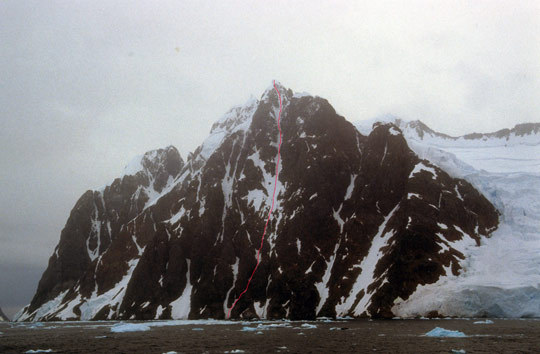
The obvious ridge in photo center is the northwest flank of Mt. Parry (2520m), one of the most coveted unclimbed lines on the Antarctic Peninsula. While a team of New Zealanders were en route to Brabant Island to climb the ridge in January, French alpinists Mathieu Cortial, Lionel Daudet and Patrick Wagnon snuck in to bag the previously unattempted line. The trio went on to establish numerous other masterpieces across the peninsula during their 75-day expedition. [Photo] Lucas Trihey / escalade.com.au
Mathieu Cortial, Lionel Daudet and Patrick Wagnon recently returned from Antarctic waters after an incredible string of first ascents on the Antarctic Peninsula. The French trio spent 75 days ticking objectives so major that Antarctic climbing historian and Alpinist correspondent Damien Gildea classified their trip as “arguably the most significant and successful climbing expedition to the Antarctic Peninsula in modern times.”
Their first success came in mid-January, on Smith Island, in the South Shetland Islands. The team picked out a western slope on the northeast summit of Mt. Foster (2105m), a peak first climbed in 1996 after abominable storms thwarted numerous teams. Though weather proved no issue this time, the route offered its own challenges: Cortial took a 50-foot fall, and an overhanging serac collapsed–with Daudet on it–nearly crushing him. They burrowed through rime mushrooms to reach the top at 2 a.m. on January 12. Their ascent, the mountain’s second, took 15 hours, and they named it Le Vol du Serac.
The weather didn’t hold for long. Sailing south, they encountered storms and harbored in the Melchior Islands. A week later, when the sky temporarily relented, the boat dropped the team on the west coast of Brabant Island, and they immediately started climbing.
Mt. Parry’s (2520m) northwest ridge rises more than 8,000 feet straight out of the sea. The ridge, an obvious and coveted mountaineering objective, had been eyed for many years but never attempted. A sponsored expedition out of New Zealand was en route to the same objective; when they heard the French had scooped them, the Kiwis changed course and climbed elsewhere.

Bon Anniversaire Tristan (ED+, 1100m) on the west face of Savoia Peak, Wiencke Island, Antarctic Peninsula. [Photo] Damien Gildea / antarcticmountains.com
The French climbers scrambled up the first half of the ridge on Day 1. Bad snow conditions and returning poor weather kept them from advancing for nearly 40 hours. They then resumed the climb, navigating crevasses to ca. 7,000′ without issue, but soft, wet snow slowed them down for the final push. It worsened as they climbed, and Wagnon spent four hours trudging up the final 100 meters to the summit. They reached top around 6 p.m. on January 23.
Nineteen hours after summiting, the team was back on shore. Raging weather kept their boat at bay, and a rogue wave swept away most of their supplies, including their tent. They built a snow cave and weathered a cold night before the boat could approach shore.
Continuing south, they stopped for another objective, this time an obvious but risky ice route on Wiencke Island.
“Visible to all who see Savoia Peak is a narrow ribbon of ice on the left of the west face that had climbers talking,” Gildea said. “But witnessing large avalanches down the same face had them going somewhere else.” Not Cortial, Daudet and Wagnon. Their first attempt on January 28 ended abruptly on the ski approach because of poor weather. Two days later they returned and, over 13 hours, sent the line: Bon Anniversaire Tristan (ED+) involved 800 meters of steep ice followed by 300 meters of ridge climbing.
Continually drawn south into even more remote terrain, the team picked off two more first ascents in February. First, 42 Balais et Toujours pas Calme, a 550-meter line of ice on the western summit of False Cape Renard, just south of Cape Renard Tower (aka Una’s Tits). Next was La Mystique des Corniches…ons, an obvious serac-capped couloir on the east face of Booth Island’s Wandel Peak (980m). Topping both of its summits, their climb is believed to be Wandel’s first true ascent.
Still more: Cortial, Daudet and Wagnon found an overhanging flow of ice on the west-northwest face of an unclimbed mountain, Statham Peak (1123m). On February 18, they made quick work of it, scoring the virgin summit in 12 hours. The route might be the “steepest technical ice climbing ever done in Antarctica,” Gildea said.
During their uncommonly long time in Antarctic waters–most Antarctic climbing trips last about 30 days, Gildea said, whereas this team traveled for 75 days–the three hoped to reach Alexander Island, which houses a number of significant but difficult-to-reach unclimbed summits. Weather and sea-ice conditions complicated their plans. The result, instead, was one last climb on Lars Christensen Peak (1775m) on Peter 1st Island. Crevasses and blustery conditions turned them back on this final clamber, an ironic end to such a successful trip.

Les Mystiques de Corniches…ons, east face of Wandel Peak, Antarctic Peninsula. [Photo] Damien Gildea / antarcticmountains.com